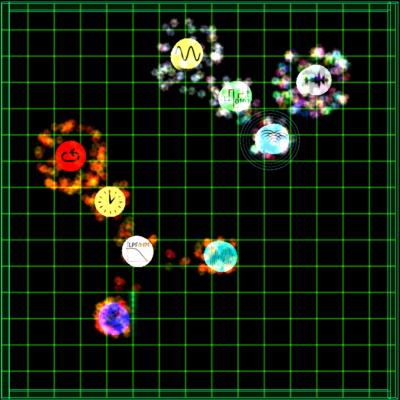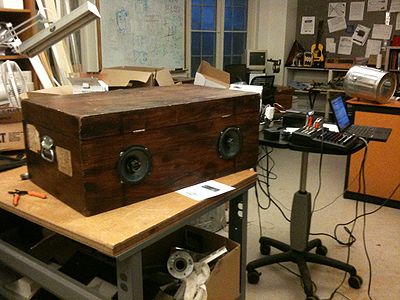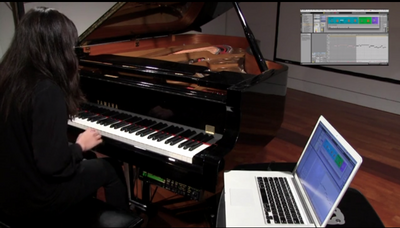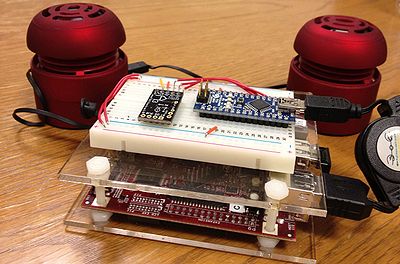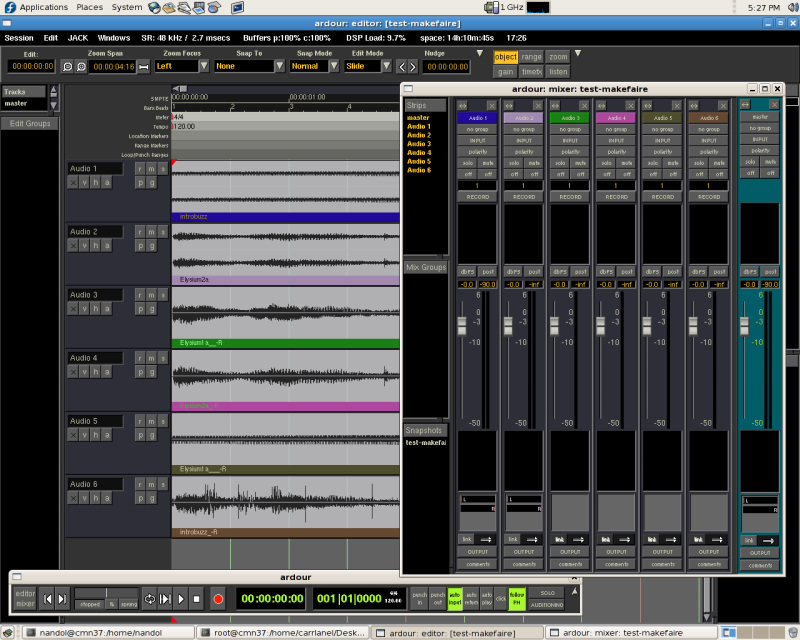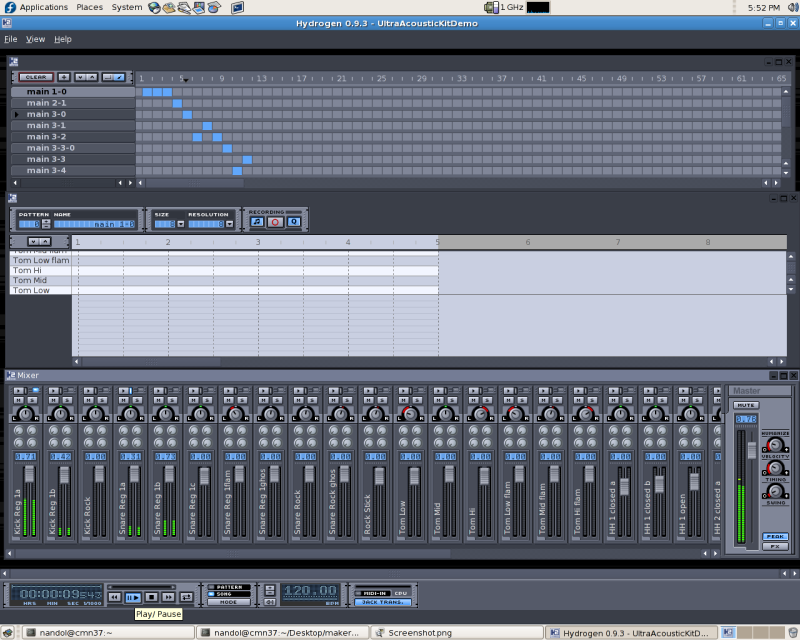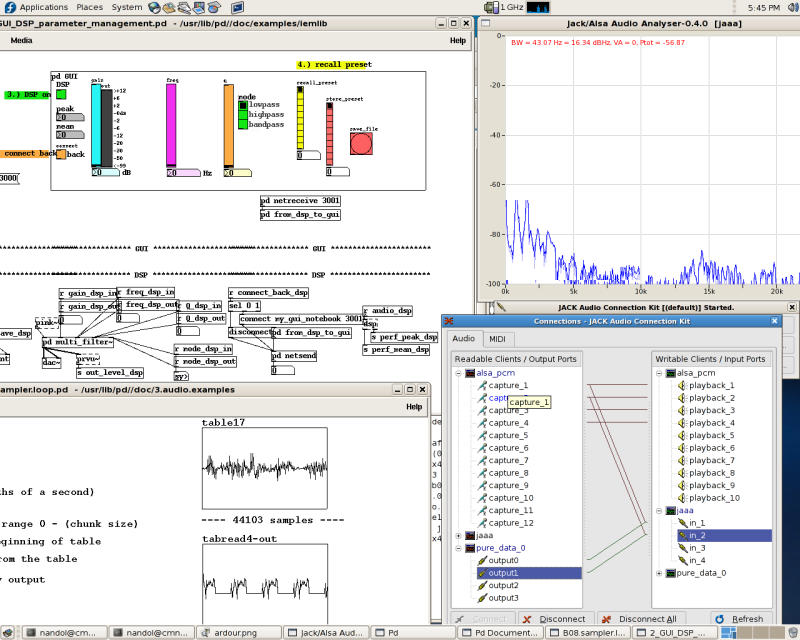MakerFaire
Contents
Introduction
The Center for Computer Research in Music and Acoustics (CCRMA -- pronounced "karma") is an interdisciplinary center at Stanford University dedicated to artistic and technical innovation at the intersection of music and technology. We are a place where musicians, engineers, computer scientists, designers, and researchers in HCI and psychology get together to develop technologies and make art. In recent years, the question of how we interact physically with electronic music technologies has fostered a growing new area of research that we call Physical Interaction Design for Music. We emphasize practice-based research, using DIY physical prototying with low-cost and open source tools to develop new ways of making and interacting with sound. At the Maker Faire, we will demonstrate the low-cost hardware prototyping kits and our customized open source Linux software distribution that we use to develop new sonic interactions, as well as some exciting projects that have been developed using these tools. Below you will find photos and descriptions of the projects and tools we will demonstrate.
The Siren Organ
Gina Collecchia, Kevin McElroy, Dan Somen
Description: The Siren Organ is an electro-mechanical instrument consisting of compressed air and motor-driven disks with evenly spaced perforations. Three different controllers were designed, each with a dedicated disk (the siren). These controllers contain a network of air tubes to direct air flow from a compressor to individual rings on the sirens. These rings have different numbers of equally spaced holes to create a fundamental frequency, and varying radii of the holes to create harmonics.
The motor speed can be controlled by a fader, creating frequency sweeps that are classic to the siren sound. A custom manifold of valves, buttons, and air pathways as well as ball valves and blow guns control the pressure of the compressed air. Hence, the performer can control volume in addition to pitch. A master valve connects to each controller and splits into 4 hoses + valves, to provide an upper limit of the possible pressure. The hose leading from the compressor is also split into 3 channels, feeding each controller.
Sonic Drop
Elliot Kermit-Canfied, Pablo Castellanos, Cooper Newby, Justin Li
Sonic Drop is an interactive and integrated audio-visual sculpture. Comprised of water activated sensors mounted on a suspended, internally lit cube that glows in response to human interaction with the device. Synthesizing visual art with sound, when the water sensors are activated, Sonic Drop generates beautiful music. Sonic Droplet will be an art installation at Stanford that invites its viewers to wield water toys to collaboratively create mesh of sound and light.
CollideFx
Chet Gnegy
CollideFx is a real-time audio effects processor that integrates the physics of real objects into the parameter space of the signal chain. Much like in a traditional signal chain, a user can choose a series of effects and offer realtime control to their various parameters. In this work, we introduce a means of creating tree-like signal graphs that dynamically change their routing in response to position changes of the unit generators. The unit generators are easily controllable using the click and drag interface and respond using familiar physics, including conservation of linear and angular momentum and friction. With little difficulty, users can design interesting effects, or alternatively, can fling a unit generator into a cluster of several others to obtain more surprising results, letting the physics engine do the decision making.
O^3: A Controller Based Around Concentric Circles
David Bordow, Erich Peske
Our controller is a prototype based around one of the most fundamental controls: a turntable. Our goal is to implement the turntable in a way that has never been done. Using a stacked-gear mechanism, we are able to put one disk on top of another on top of another. The user will theoretically be able to hook up the O^3 to any editable parameter allowing fluid, tactile, and precise control for use in sampling, ambient, or whatever the imagination creates. We hope to continue our work on the controller into the next quarter and will strive to improve the product over time.
Busk Box
Sasha Leitman
The Busk Box is a street performance system that combines the traditions of wandering street performers and musicians with the modern technologies. Inside of a 1911 wooden trunk, 2 6" speakers, 1 10" subwoofer, 2 class-T amplifiers and a portable mixer are all powered by lithium-ion batteries. In addition, the box is supported by folding wheels and legs which enable the box to be set up and torn down in less than 3 minutes. This platform was designed to bring experimental and electronic music to the San Francisco Fisherman's Wharf district.
Jnana
Colin Sullivan
“Jnana” is a generative musical accompaniment system integrated into Ableton Live. It has the ability to analyze MIDI input and generate new material in a similar style. It can analyze input in real-time or from desired clips within Ableton and can populate Ableton clips with new material.
Satellite CCRMA
Ed Berdahl, Wendy Ju Satellite CCRMA promotes rapid prototyping of new media. Used by artists and engineers alike, Satellite CCRMA integrates together open-source software and hardware projects. Most importantly, it comes with examples that make it possible for new users to get up and running within a matter of minutes. For more info, please see https://ccrma.stanford.edu/~eberdahl/Satellite/
Software Tools
Planet CCRMA at Home is a collection of open source programs that you can add to a computer running Fedora Linux to transform it into an audio/multi-media workstation with a low-latency kernel, current audio drivers and a nice set of music, midi, audio and video applications (with an emphasis on real-time performance). It replicates most of the Linux environment we have been using for years here at CCRMA for our daily work in audio and computer music production and research. Planet CCRMA is easy to install and maintain, and can be upgraded from our repository over the web. Bootable CD and DVD install images are also available. This software is free.
http://ccrma.stanford.edu/planetccrma/software
Ardour - Multitrack Sound Editor
Hydrogen - Drum Sequencer
Pd, Jack and Jaaa - Real-time audio tools


